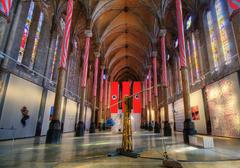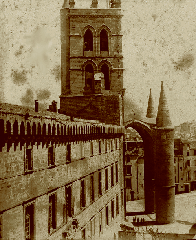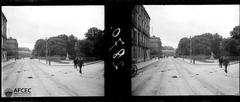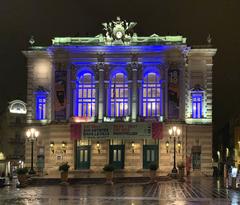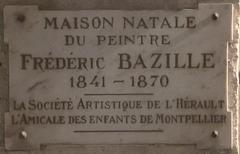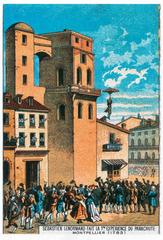Hôtel de la Société Royale des Sciences: Visiting Hours, Tickets, and Comprehensive Guide to Montpellier’s Historical Site
Date: 03/07/2025
Introduction
Situated in the heart of Montpellier, France, the Hôtel de la Société Royale des Sciences—also referred to as Hôtel de Lunas or Hôtel de Guilheminet—is a landmark of scientific, architectural, and cultural importance. Established in 1706 during the reign of Louis XIV, this 17th and 18th-century hôtel particulier served as the headquarters of the Royal Society of Sciences of Montpellier. The institution played a pivotal role in Montpellier’s emergence as a leading center of Enlightenment thought and scientific progress.
While the Hôtel remains primarily an active academic site, it offers rare public access during special events such as the European Heritage Days, providing an exceptional opportunity to explore its architectural splendor and Montpellier’s rich intellectual heritage. Its proximity to key city landmarks—including Place de la Comédie, Cathédrale Saint-Pierre, and the Jardin des Plantes—makes it a cornerstone for visitors interested in France’s scientific and cultural history.
This detailed guide covers the Hôtel’s historical background, architectural features, visiting hours, ticketing, accessibility, travel tips, and nearby attractions, equipping you with everything needed for an enriching experience. For the latest updates, consult official resources such as the Montpellier Tourism Official Site and the Académie des sciences et lettres de Montpellier.
Table of Contents
- Introduction
- Historical Background
- Architectural and Cultural Significance
- Visiting Information
- Visitor Experience
- Tips for Visitors
- Frequently Asked Questions (FAQ)
- Conclusion
- Sources and Official Links
Historical Background: Origins and Significance
Origins and Early Development
The Hôtel de la Société Royale des Sciences traces its roots to the medieval era, but its most significant transformation came in the 17th and 18th centuries. In 1635, architect Simon Levesville remodeled the mansion for Pierre de Guilleminet, a notable clerk to the States of Languedoc (Monumentum). A subsequent renovation in 1776–1777, led by Jean Antoine Giral, prepared the building for its new role as home to the Société Royale des Sciences, reflecting the grand ambitions of Montpellier’s scientific community (Monumentum).
The Société Royale des Sciences: Foundation and Legacy
Founded by royal decree in 1706, the Société Royale des Sciences de Montpellier was modeled after the prestigious Académie des Sciences in Paris. Its creation, encouraged by King Louis XIV, was intended to expand scientific inquiry and royal influence in the south of France (Académie des Sciences et Lettres de Montpellier). The statutes mandated close collaboration with the Parisian academy, including the sharing of publications and reciprocal access for members. The Society rapidly became a hub for research and debate, contributing to advancements in medicine, botany, chemistry, and physics, and playing a central role in the French Enlightenment.
Although the original society was dissolved during the French Revolution, its spirit endures through the Académie des Sciences et Lettres de Montpellier, which continues to promote scholarly exchange in the city (Académie des Sciences et Lettres de Montpellier).
Architectural and Cultural Significance
Architectural Features and Style
The Hôtel de la Société Royale des Sciences is a quintessential Montpellier hôtel particulier, characterized by:
- Grand Portal and Wrought Ironwork: The impressive street-facing entrance, with its ornate iron doors and knocker, is protected as a historical monument (Monumentum).
- Central Courtyard: The quadrilateral layout features a tranquil, private courtyard—emblematic of Montpellier’s urban aristocratic tradition.
- Staircase and Iron Railing: A refined staircase with decorative ironwork, another listed feature.
- Elegant Facades and Interiors: Symmetrical stone facades, classical ornamentation, and grand interior spaces reflect the building’s noble origins (Montpellier Tourism).
Protected Elements and Urban Context
Both the grand portal and the staircase’s iron railing are protected under French heritage laws. The mansion’s integration into the old quarter, L’Écusson, enhances its historic value and provides a unique lens on Montpellier’s urban evolution (The Crazy Tourist).
Role in Montpellier’s Scientific and Cultural Landscape
The Hôtel was the epicenter for Enlightenment-era scholarship, hosting influential figures who contributed to major scientific advances and the famous Encyclopédie. Its legacy is preserved by the academy’s vast library, with 40,000 volumes managed in partnership with the Bibliothèque Interuniversitaire de Montpellier.
Visiting Information
Visiting Hours and Ticketing
- Regular Access: The Hôtel is not open to the public on a daily basis due to its academic use and private ownership.
- Special Events: Public access is offered during annual events such as the European Heritage Days (Journées Européennes du Patrimoine) in September, as well as select exhibitions and lectures.
- Tickets: Normally, entry during these events is free; some special exhibitions or tours may require advance registration or a modest fee (Montpellier Tourism).
Guided Tours and Special Events
Guided walking tours of Montpellier’s historic center, organized by the Tourist Office, frequently include stops at the Hôtel. Interior tours are usually possible only during special openings.
Accessibility
As a historic building, accessibility is limited. Wheelchair access and other accommodations may be provided during public events; always contact the Montpellier Tourist Office in advance to confirm options.
How to Get There
- By Tram: Lines 1 or 3 to the Comédie stop, followed by a 5-minute walk.
- By Bus: Several lines serve Place de la Comédie.
- By Car: Parking is limited in the old city; public transit or walking is recommended. The Hôtel is centrally located near key attractions.
Visitor Experience
What to See
- Exterior: The grand portal, façade, and ornamental ironwork.
- Courtyard: During special events, the courtyard offers insight into the mansion’s original design.
- Photographic Opportunities: The surrounding streets and the building’s architecture are ideal for photography enthusiasts.
Nearby Attractions
- Musée Fabre: Montpellier’s leading art museum (Musée Fabre).
- Place de la Comédie: The city’s vibrant square.
- Jardin des Plantes: France’s oldest botanical garden (Lonely Planet).
- Other Hôtels Particuliers: The city is home to numerous historic mansions, many accessible on guided tours (The Crazy Tourist).
Visual Experience and Media
Official tourism websites provide high-quality images and, occasionally, virtual tours that showcase the Hôtel’s architectural details and historic ambiance.
Tips for Visitors
- Plan Ahead: Check Montpellier Tourism and event listings for special opening dates.
- Combine Visits: Explore other nearby historical sites for a full day of cultural immersion.
- Respect Private Ownership: The Hôtel is privately owned—do not attempt unauthorized entry.
- Use Digital Resources: Download the Audiala App for guided audio tours and historical context.
Frequently Asked Questions (FAQ)
Q: Can I visit the Hôtel de la Société Royale des Sciences year-round?
A: No, regular access is only available during special events such as the European Heritage Days.
Q: Is there an entrance fee?
A: Entry is generally free during public events, but some tours or exhibitions may require advance registration or a fee.
Q: Is the Hôtel accessible for people with disabilities?
A: Accessibility is limited; contact the Tourist Office for event-specific details.
Q: Are guided tours available?
A: Yes, through the Montpellier Tourist Office, especially during major events.
Q: Can I take photos inside?
A: Photography is allowed in public areas during events; restrictions may apply in certain spaces.
Conclusion
The Hôtel de la Société Royale des Sciences stands as a symbol of Montpellier’s commitment to intellectual achievement and urban elegance. While regular public access is limited, special events provide a unique opportunity to experience this monument’s architectural and scholarly legacy firsthand. Combine your visit with other historical sites to fully appreciate the city’s vibrant heritage.
For the most current information, consult the Montpellier Tourism Office and the Académie des sciences et lettres de Montpellier. Enhance your visit using the Audiala App for guided tours and cultural insights.
Sources and Official Links
- Montpellier Tourism Official Site
- Hôtel de la Société Royale des Sciences – Visitor Info
- Académie des sciences et lettres de Montpellier official site
- Monumentum.fr – Hôtel de la Société Royale des Sciences
- The Crazy Tourist – 15 Best Things to Do in Montpellier
- Musée Fabre Official Site
- Lonely Planet Montpellier Guide
- Audiala App for Guided Tours
